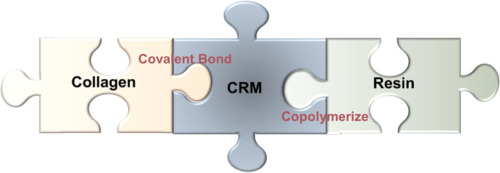Biomaterials Advances ( IF 5.5 ) Pub Date : 2020-03-26 , DOI: 10.1016/j.msec.2020.110902 F Yu 1 , R C Xu 2 , L Huang 3 , M L Luo 1 , J Li 1 , F R Tay 4 , L N Niu 4 , J H Chen 1

|
When damaged or fractured collagen-rich hard tissues are repaired by resin material, the collagen matrix may be used as a scaffold, after removal of the natural minerals, for resin monomers to penetrate and polymerize in-situ. Formation of a collagen-polymer hybrid biocomposite via mechanical hybridization provides a stable and strong link between endogenous tissue and the prosthesis for successful clinical integration. However, the heterogeneity between hydrophobic resin polymers and hydrophilic collagen presents a challenge to the quality of hybrid biocomposite. The objective of the present study was to evaluate the potential benefits of a collagen-reactive monomer (CRM, an isocyanate-terminated urethane-based methacrylate) with covalent affinity to collagen as “chemical link” to enhance in-situ resin hybridization within a collagen scaffold. Here, the CRM ligand with active isocyanate group may be chemically grafted onto the collagen receptor via covalent and hydrogen bonds. Dentin-derived collagen chemical modified by CRM shows improved mechanical property, thermostability and enzymatic stability. Moreover, CRM inhibited both exogenous and endogenous collagenase activities. The modification of collagen by chemical grafting of resin monomers improved its mechanical and physicochemical properties and demonstrated the potential of CRM for use in promoting chemical adhesion and creating a much stronger and durable bonding interface. Formation of a chemical bond between polymer and collagen scaffold in-situ improves the mechanical performance of collagen and may create a much stronger and durable collagen-polymer hybrid material. Addition of CRM into adhesives might effectively prolong the longevity of clinical resin-bonded restorations.
中文翻译:

异氰酸酯封端的氨基甲酸酯基甲基丙烯酸酯,用于原位胶原蛋白支架修饰。
当通过树脂材料修复受损或破裂的富含胶原蛋白的硬组织时,胶原蛋白基质可以在除去天然矿物质后用作支架,以使树脂单体渗透并原位聚合。通过机械杂交形成胶原蛋白-聚合物杂化生物复合材料,为成功进行临床整合提供了内源性组织与假体之间的稳定而牢固的联系。然而,疏水性树脂聚合物和亲水性胶原之间的异质性对杂化生物复合材料的质量提出了挑战。本研究的目的是评估对胶原具有共价亲和力的胶原反应性单体(CRM,异氰酸酯封端的氨基甲酸酯基甲基丙烯酸酯)作为“化学连接”的潜在益处,以增强胶原内的原位树脂杂交脚手架。在此,具有活性异氰酸酯基的CRM配体可以通过共价键和氢键化学接枝到胶原受体上。CRM修饰的牙本质衍生胶原蛋白显示出改善的机械性能,热稳定性和酶稳定性。此外,CRM抑制外源和内源性胶原酶的活性。通过树脂单体的化学接枝对胶原蛋白进行的改性改善了其机械和物理化学性能,并证明了CRM在促进化学粘合和创建更坚固耐用的粘合界面方面的潜力。在聚合物和胶原蛋白支架之间原位形成化学键改善了胶原蛋白的机械性能,并且可以产生更坚固和耐用的胶原蛋白-聚合物杂化材料。











































 京公网安备 11010802027423号
京公网安备 11010802027423号